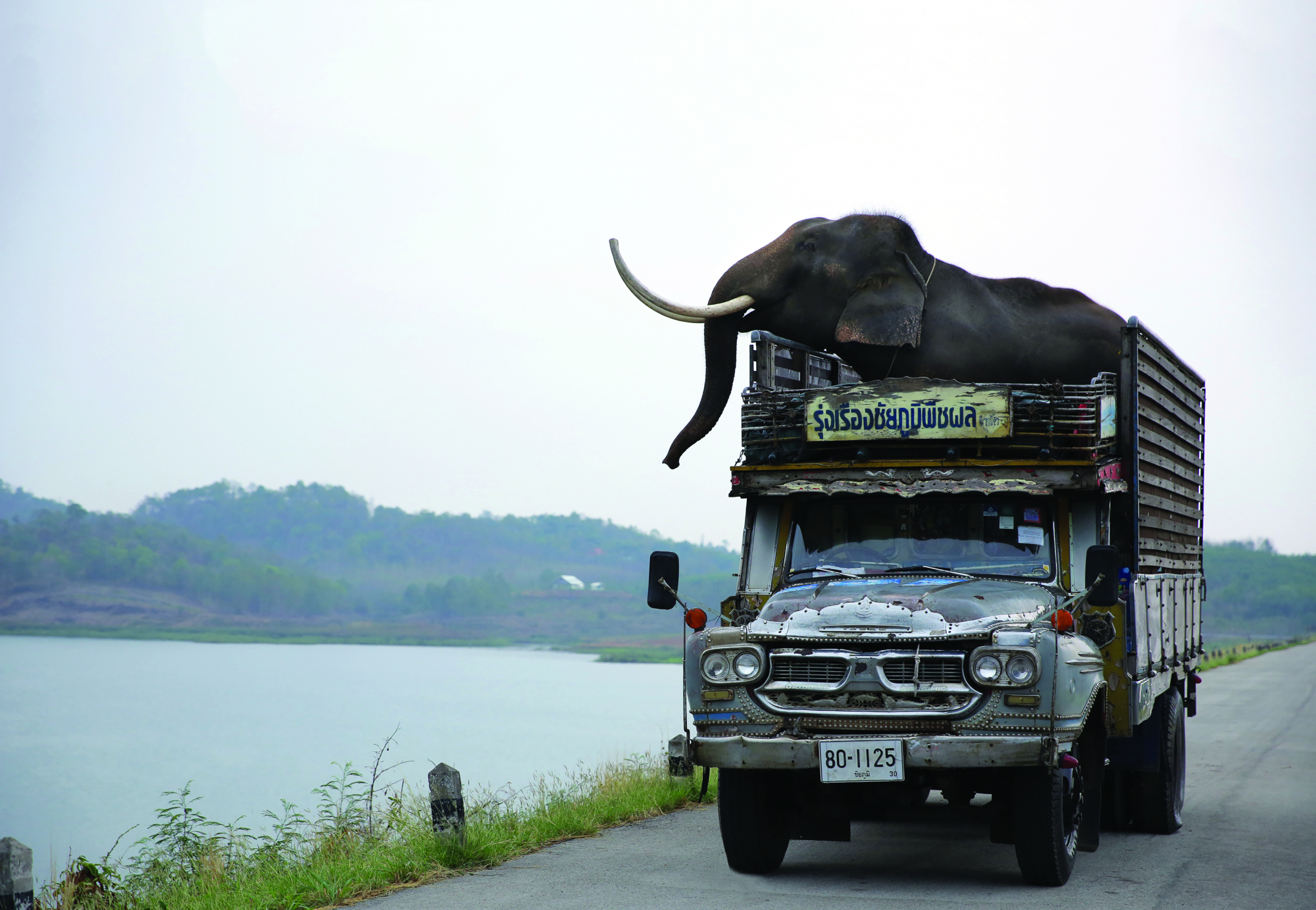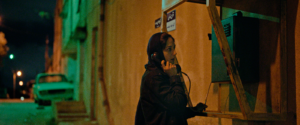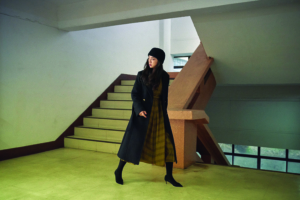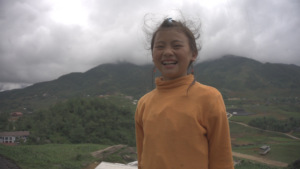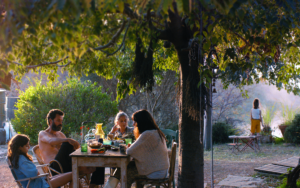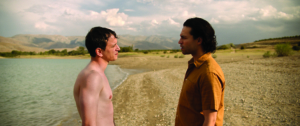The typical road movie finds profundity in the quotidian, drawing together apparently unrelated encounters into an overarching, epiphanic tapestry. It’s tempting to so categorise Kirsten Tan’s Pop Aye (2017), which follows the journey of middle-aged architect Thana (Thaneth Warakulnukroh) and his childhood friend, a fully-grown Indian elephant named Popeye, across Thailand. While Thana and Popeye’s journey hit the familiar narrative beats of the road movie, however, Tan’s screenplay resolutely resists romanticising the open road.
That’s not to suggest Pop Aye avoids the contemplative rhythm found in the greats of its genre. To my eye, it most closely resembles – in both tone and narrative – David Lynch’s gentle The Straight Story (1999); just trade the old ride-on mower for an old elephant, and Midwest America for north-eastern Thailand. The films share the same sedate pace, the same undercurrent of surrealism, the same defiance of a neat narrative, while nonetheless coalescing into something coherent. As in Lynch’s film, Tan frames her protagonist’s journey as an opportunity for him to reflect on his life – the road before him, and the road stretching into the distance. Pop Aye posits that the meanings we impose on our personal histories are just as impermanent as the lines drawn on this road: fading into oblivion, or replaced by fresh white paint after we’re gone.
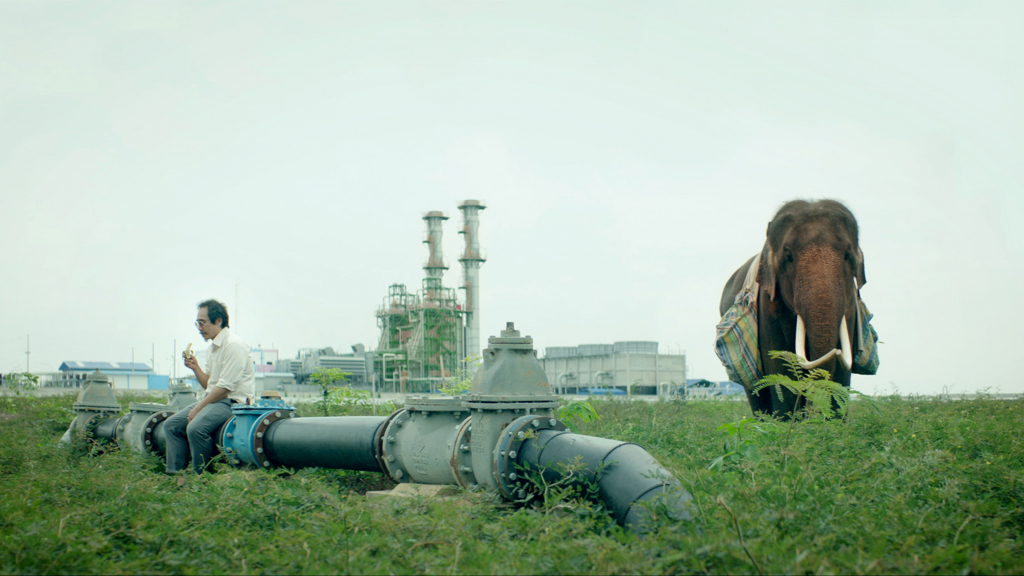
Hero’s journey
When we first meet Thana, he’s undergoing a midlife crisis of sorts. Okay, that’s not entirely true – the film, befitting its loosely nonlinear structure, opens on the open road as Thana and Popeye commence their long journey – but, certainly, the seed of the story comes from its protagonist’s increasing dissatisfaction with his life.
Thana appears on a morning chat show to discuss the impending demolition of Gardenia Square, a Bangkok high-rise that he designed as his ‘first project as key architect’ for the Star Design Assembly firm. Now that he has to work alongside the company’s new, young CEO, his discomfort at the erasure of his legacy is palpable. ‘We were young and idealistic then,’ says Thana, while his boss nonchalantly observes that ‘the old has to make way for the new’.
Things are no more welcoming at home. Our ageing architect lives in an expansive, modern house but, despite such opulent surrounds, the atmosphere between him and his wife, Bo (Penpak Sirikul), is thoroughly frosty. The film’s first act serves to emphasise Thana’s increasing irrelevance, whether at work – where he discovers a critical meeting has been completed without his presence – or at home, where he stumbles upon a vibrator barely concealed among his wife’s things. This is a portrait of a man whose success has brought him no satisfaction.
Enter Popeye. Thana first spots the elephant, bedecked in colourful sheets, as he’s driven away from the television studio; he later returns to find the creature, which he identifies as his childhood ‘pet’ when it responds to an old song they once shared. After buying Popeye – now named ‘Chang Beer’ – from his owner, our protagonist decides to set off for his home town of Loei. For Thana, the elephant and town alike represent the nostalgic promise of abandoned youth, the possibilities that filled his head as a young architect – possibilities that now seem to be decaying before his very eyes.
For Thana, the elephant and town alike represent the nostalgic promise of abandoned youth, the possibilities that filled his head as a young architect – possibilities that now seem to be decaying before his very eyes.
Tan and director of photography Chananun Chotrungroj depict Popeye with a soft, wistful gaze. The elephant is presented as an icon – memorably captured in the fleeting reflection of a puddle, haloed by Bangkok’s night-time neon lights – but also shot with a sympathetic lens that evokes a distinctive personality. That’s deliberate, as Tan notes in the film’s press kit: ‘I wanted the elephant to be something that was true to my character’s life. It was definitely not going to be an exotic, Disney elephant placed in there for colour.’[1]Kirsten Tan, ‘Director’s Artistic Statement’, in Cercamon, Pop Aye press kit, 2017, p. 6. This intent is reinforced by directorial choices that refuse to objectify the elephant – Popeye is not merely a symbol of Thana’s youth, but a character in his own right.[2]Further reinforced by the top billing of Bong, the elephant playing Popeye.
Thana and Popeye’s subsequent journey is framed as a quest for meaning, a path into Thana’s past that interrogates his future. This is all implicit – the architect explains the purpose of his trip to no-one – but it’s clear that the imminent destruction of his high-rise creation has prompted big questions relating to legacy and memory. Thana may be travelling to Loei to relive his memories of a simpler time or, perhaps, to see how (or if) he is remembered there.
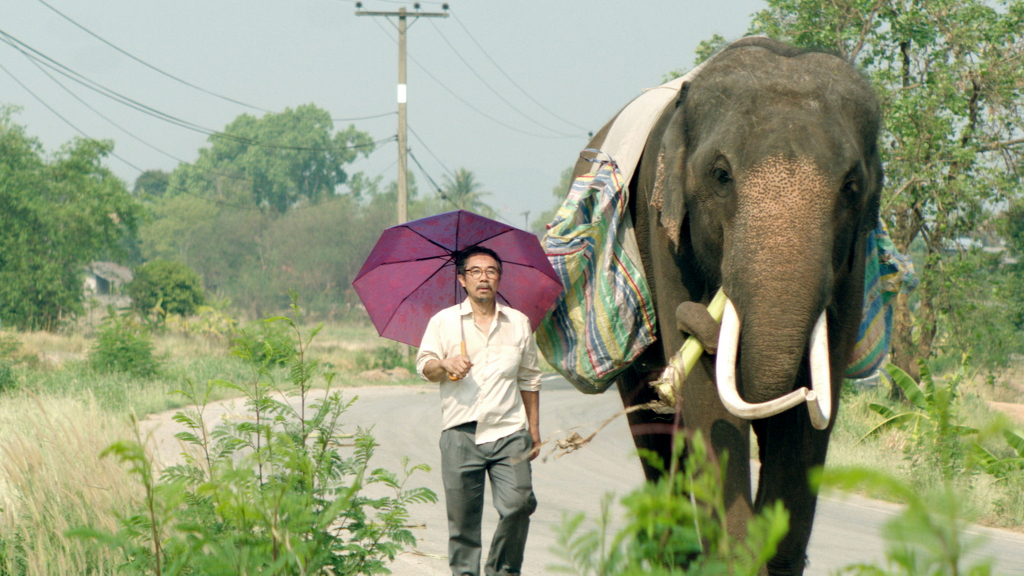
Helpers on the path
Memory is integral to Pop Aye. Significantly, however, for the bulk of its running time, the film carefully avoids examining Thana’s recollections in any great detail. He doesn’t regale those he meets on his journey with stories of his past, nor are we treated to flashbacks of his childhood until quite late in the piece. When they arrive, these flashbacks centre on Popeye: the discovery of the young elephant after Thana’s mother’s death (while an episode of the Popeye cartoon plays on television), and young Thana and Popeye frolicking in a Loei lake. It’s clear that, in part, this is a formal strategy used to keep the audience’s focus on the present. By reducing the emphasis on where Thana is going, we attend to the particulars of his encounters on the road – again aided by Tan and Chotrungroj’s humanistic camerawork – rather than anticipating the destination. But it also suggests an act of denial on Thana’s part: he represses the less palatable features of his childhood in order to avoid destabilising his carefully curated identity. The erosion of his self-worth in the film’s first act is only the beginning of a path towards personal acceptance – a path that requires honest engagement with his past.
Per the requirements of the road-movie genre, Thana can’t attain such acceptance himself, but must be led there through his encounters along the way. His first such significant encounter is with a vagrant named Dee (Chaiwat Khumdee), found squatting by the side of the highway. Dee is the polar opposite of Thana: tranquil skies versus an anxious thunderstorm. Dee’s peaceful disposition even extends to his own mortality, as he tells his new companion, ‘I’m going to join my brother in heaven […] I read it in the stars.’ Dee’s mysticism and asceticism suggest an antidote to Thana’s anxiety: to embrace internal peace, rather than fretting over one’s purpose and legacy. But, just as Tan’s direction refuses to simplify her titular animal into a signifier, here she resists the temptation to flatten Thana’s encounter with Dee into a dot point on his self-actualisation to-do list. Dee is portrayed empathetically; as with Popeye, the camera refuses to simplify him into solely a symbol (though he is arguably on the unrealistic side of beatific).
The two men are separated shortly after meeting when Popeye escapes outside a local supermarket and is detained by police; as Thana lacks an ‘elephant licence’, he is arrested for ‘negligence and violating urban tidiness’. This subplot, in which a pair of policemen escort Thana and Popeye down the road at ‘elephant speed’, is a showcase for the screenplay’s wry comedy. Dee’s storyline, however, takes a more tragic turn, as he meets a fatal end in an accident while riding Thana’s motor scooter (a gift) on the way to fulfil his one dream: to take his sweetheart out for a ride.
Yet it’s not Dee’s death that clarifies the film’s – to borrow the director’s words – ‘existential themes’,[3]Kirsten Tan, quoted in Jeremy Elphick, ‘Pop Aye – an Interview with Kirsten Tan’, 4:3, 21 June 2017, <https://fourthreefilm.com/2017/06/pop-aye-an-interview-with-kirsten-tan/>, accessed 2 November 2017. but rather what Thana discovers when he sets out to honour his erstwhile friend’s memory. Dee’s true symbolic purpose is clarified when Thana visits ‘Dee’s girl’, only to learn that she has settled down with a family and hasn’t seen her ex-boyfriend in years. Narratively, this serves a necessary purpose – Thana is able to borrow a truck from her, which allows him to complete his voyage to Loei – but, more significantly, it reflects our protagonist’s own denial about his past: memories that he’s edited and erased in an effort to refine his self-image.
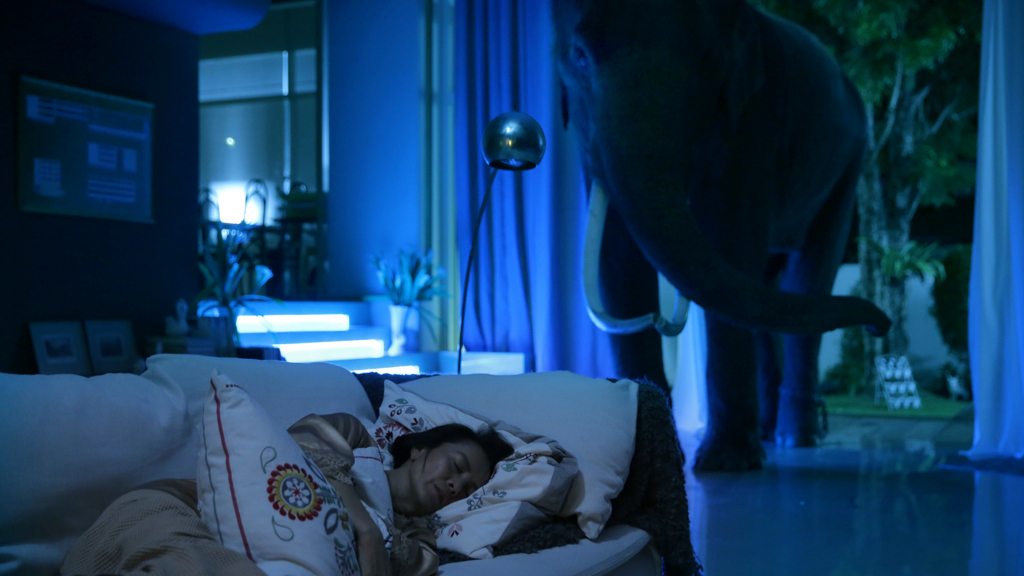
Hitting home
Thana’s eventual arrival in Loei brings with it three revelations. One: his childhood home has been remade by developers into a generic apartment building. Two: Thana sold Popeye to a circus prior to leaving for Bangkok, to fund his architectural studies there. And three: the elephant Thana has travelled with for over several hundred kilometres is not, in fact, Popeye, but an unrelated elephant. Popeye, we’re reliably informed, was put down years earlier after he was injured at the circus.
These last two developments clarify the thematic thrust of the film. For Thana, this elephant was more than just an opportunity to travel down memory lane during a dark time. ‘Popeye’ represented the possibility of redemption, the chance to salve a guilt that had clearly lingered for decades. But Thana’s arrival in Loei quashes that possibility with devastating finality. He sold out the optimism of the youth – and the elephant, besides – for the ashen failure of adulthood. His legacy is a crumbling marriage and a building scheduled for destruction.
Pop Aye doesn’t cushion the force of this blow – but, critically, we come to understand that Thana’s journey to this point has prepared him to accept the bitterness of his circumstances. The film concludes with a tentative reunion between Thana and Bo in the desecrated remains of Gardenia Square, surrounded by the vacant simulacra of dusty mannequins.[4]Possibly an oblique reference to how Thana and the audience impose meaning on his random encounters on the road; probably just mannequins. She gently shares a story of weathering an earthquake in the building, feeling confident in her safety ‘because you built this’. It’s a bittersweet conclusion. Thana has returned to Bangkok, where his journey began, with no greater sense of purpose, though now he’s blessed with the ability to accept his circumstances in all their imperfections. It brings to mind the oft-quoted chestnut, ‘Don’t cry because it’s over, smile because it happened,’ which surely isn’t accidental if this passage from Tan’s director statement is anything to go by: ‘Time is the witness to it all and when time shows its hand, do we laugh or do we cry?’[5]Tan, ‘Director’s Artistic Statement’, op. cit.
I’ve perhaps misrepresented the film by focusing purely on Thana’s personal journey. Pop Aye is, more broadly, a story about our inability to craft our personal histories – about how our legacies are not our own, and how our pasts aren’t neat narratives bent to our wills. In fact, it’s also a story about Thailand – albeit maybe not one imbued with a deep specificity. Tan is a Singaporean-born, New York–based filmmaker whose experience of Thailand comes from two years of having lived there. This experience – and, presumably, her work with Thai creatives like Lee Chatametikool, Pop Aye’s editor and a regular collaborator of prominent Thai filmmaker Apichatpong Weerasethakul – ensures that the film avoids romanticising or denigrating its setting. The demolition of Gardenia Square and the replacement of Thana’s rural home with an apartment building both hint at the encroaching arm of development, while the choice to have an elephant – which ‘symbolise[s] hopelessness’ in a country increasingly stripped of forest environments[6]Tan, quoted in Elphick, op. cit. – as the titular character nods to the consequences of such modernisation.
Such factors lend Pop Aye the same lingering melancholy seen in the elephant’s big, sad eyes. This isn’t a grandstanding work that overemphasises its political messages, and it resists the familiar road-movie formula that finds meaning at the end of the journey. Tan’s film suggests you can’t change your future, nor your past, by running away. But perhaps you can find some modicum of peace along the way.
Endnotes
| 1 | Kirsten Tan, ‘Director’s Artistic Statement’, in Cercamon, Pop Aye press kit, 2017, p. 6. |
|---|---|
| 2 | Further reinforced by the top billing of Bong, the elephant playing Popeye. |
| 3 | Kirsten Tan, quoted in Jeremy Elphick, ‘Pop Aye – an Interview with Kirsten Tan’, 4:3, 21 June 2017, <https://fourthreefilm.com/2017/06/pop-aye-an-interview-with-kirsten-tan/>, accessed 2 November 2017. |
| 4 | Possibly an oblique reference to how Thana and the audience impose meaning on his random encounters on the road; probably just mannequins. |
| 5 | Tan, ‘Director’s Artistic Statement’, op. cit. |
| 6 | Tan, quoted in Elphick, op. cit. |
